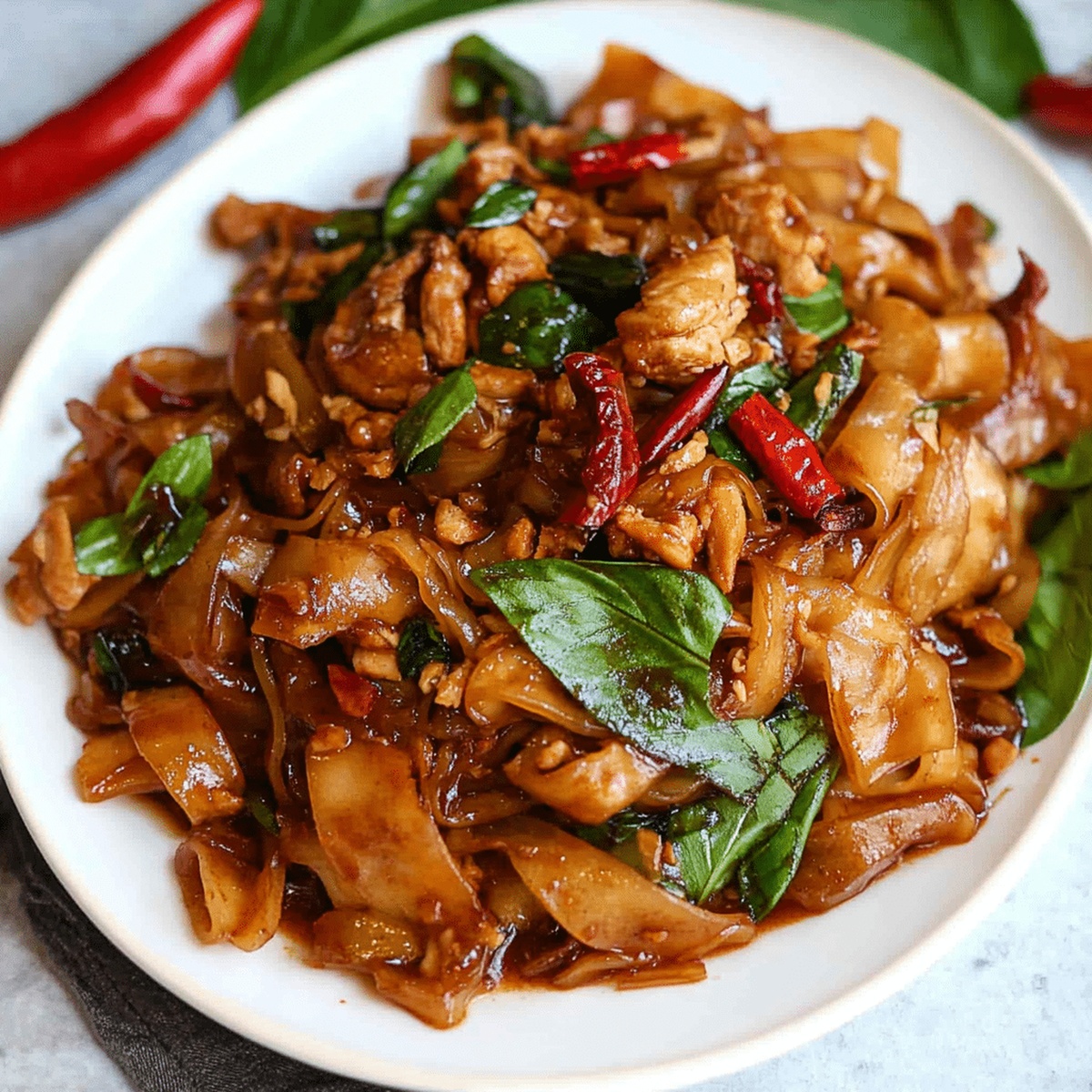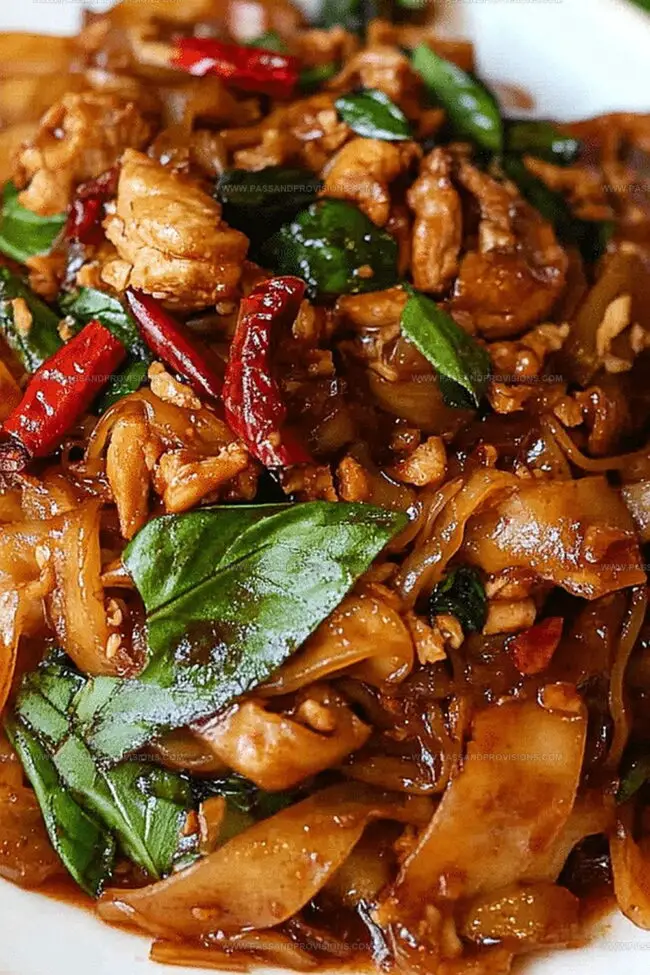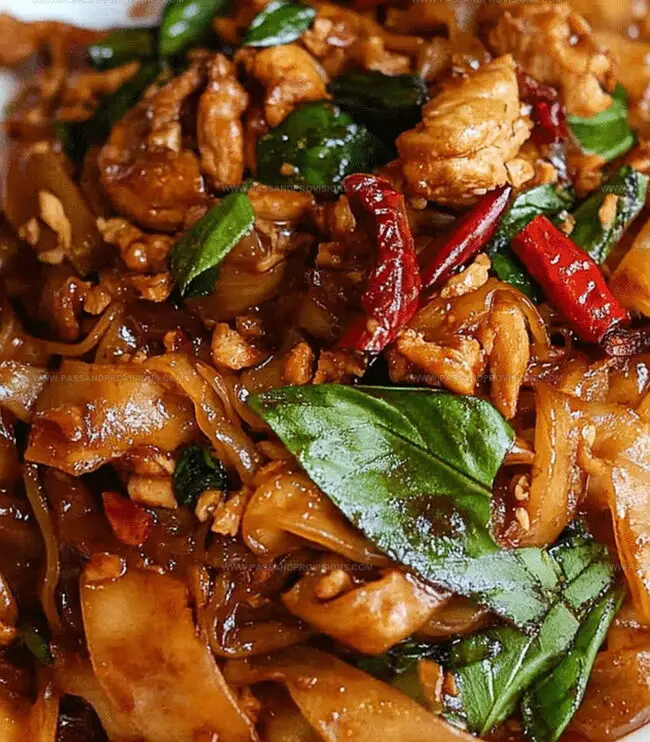Spicy Thai Drunken Noodles (Pad Kee Mao) Recipe for Noodle Lovers
Spicy and aromatic thai drunken noodles dance with bold flavors that wake up your taste buds instantly.
Friends always request this incredible dish when we gather.
Authentic street food culture comes alive through wide rice noodles simmering with chili and garlic.
Wok-seared ingredients create complex layers of sweet, tangy, and fiery sensations.
Restaurant-quality meals emerge quickly in your own kitchen with minimal preparation.
Crisp vegetables and tender protein make this recipe irresistibly satisfying.
Discover why passionate cooks consider pad kee mao a perfect balance of texture and taste.
Why Thai Drunken Noodles Are Bold and Addictive
Ingredients to Make Thai Drunken Noodles
Noodle Base:Proteins (Optional):Vegetables:Sauce Components:Herb Finish:Cooking Base:Directions for Pad Kee Mao at Home
Step 1: Create Flavor Explosion
Grab these ingredients to mix your sauce:Whisk everything together in a bowl until sugar melts completely.
Step 2: Cook Noodle Base
Boil rice noodles following package directions until they’re perfectly tender. Drain and set aside.
Step 3: Sizzle and Sear
Fire up your wok or large skillet with vegetable oil over high heat.
Toss in:Quickly stir until aromatic and fragrant.
Add your chosen protein and cook until golden and fully done.
Introduce colorful vegetables:Stir-fry for 2-3 minutes until veggies are crisp and vibrant.
Step 4: Bring Everything Together
Pour noodles into the wok.
Drench with prepared sauce.
Toss and mix until every strand is coated with deliciousness.
Sprinkle fresh Thai basil leaves.
Continue stirring for another minute.
Step 5: Plate and Devour
Transfer steaming noodles to plates.
Serve immediately while hot and bursting with flavor.
Tips for That Perfect Wok Toss
Storage and Reheating Tips for Drunken Noodles
Pair These with Thai Drunken Noodles
Variations of Thai Drunken Noodles to Try
Thai Drunken Noodle FAQ
The key difference is the bold, spicy flavor profile created by combining multiple sauces like oyster, soy, and fish sauce, along with fresh Thai basil and chilies that give it a unique, intense taste.
No, the name “Drunken Noodles” is a culinary term referring to the spicy, bold flavors that are so intense they might make you feel like you’ve had a few drinks.
Absolutely! Simply skip the protein or replace it with tofu, and use vegetarian-friendly soy sauce to create a delicious plant-based version of this classic Thai street food.
The spice level is customizable by adjusting the number of chilies. Typically, it’s medium-hot, but you can reduce or increase the chilies to match your personal heat tolerance.
Print
Thai Drunken Noodles (Pad Kee Mao) Recipe
- Total Time: 25 minutes
- Yield: 4 1x
Description
Sizzling Thai Drunken Noodles dance with bold, spicy flavors that capture street-food magic from Bangkok’s bustling kitchens. Savory rice noodles tangle with tender proteins and aromatic herbs, promising a mouthwatering journey through authentic Thai cuisine you’ll crave again and again.
Ingredients
Protein:
- 1 cup chicken, shrimp, or tofu, thinly sliced
Noodles and Base Ingredients:
- 8 ounces (226 grams) wide rice noodles
- 2 tablespoons (30 milliliters) vegetable oil
- 1 small onion, sliced
Vegetables and Herbs:
- 1 bell pepper, sliced (red or green)
- 1 cup broccoli florets
- 1 cup snap peas
- 1 cup Thai basil leaves (substitute with regular basil if unavailable)
- 2 cloves garlic, minced
- 23 Thai birds eye chilies, finely chopped (adjust to taste)
Sauce Ingredients:
- 3 tablespoons (45 milliliters) oyster sauce
- 2 tablespoons (30 milliliters) soy sauce
- 1 tablespoon (15 milliliters) fish sauce
- 1 tablespoon (15 milliliters) dark soy sauce
- 1 tablespoon (15 grams) brown sugar
Instructions
- Craft a vibrant sauce by whisking oyster sauce, soy sauce, fish sauce, dark soy sauce, and brown sugar in a small bowl until completely integrated, creating a harmonious flavor base.
- Submerge rice noodles in boiling water, following package guidelines to achieve an al dente texture. Carefully drain and reserve for later incorporation.
- Ignite a large wok with vegetable oil over medium-high heat, then introduce minced garlic and chopped chilies, releasing their aromatic essence for approximately 30 seconds.
- If utilizing protein, sear it until golden and thoroughly cooked, ensuring a rich, caramelized exterior.
- Toss sliced onion, bell pepper, broccoli, and snap peas into the wok, stirring vigorously for 2-3 minutes to maintain a crisp, vibrant vegetable profile.
- Gently fold cooked noodles into the wok, followed by the previously prepared sauce, meticulously coating each ingredient to distribute flavors evenly.
- Sprinkle fresh Thai basil leaves into the mixture, continuing to stir-fry for an additional minute until the herbs wilt and meld with the remaining components.
- Plate the drunken noodles immediately, presenting a steaming, fragrant dish bursting with Thai-inspired culinary complexity.
Notes
- Choose wide, flat rice noodles for authentic texture and best absorption of savory sauce.
- Prep all ingredients beforehand to ensure quick, seamless stir-frying without burning garlic or chilies.
- Control spice levels by adjusting the number of chilies or using milder pepper varieties for sensitive palates.
- Transform into vegetarian version by replacing protein with tofu or adding extra vegetables like mushrooms or eggplant.
- Prep Time: 15 minutes
- Cook Time: 10 minutes
- Category: Lunch, Dinner
- Method: Frying
- Cuisine: Thai
Nutrition
- Serving Size: 4
- Calories: 450
- Sugar: 5 g
- Sodium: 800 mg
- Fat: 20 g
- Saturated Fat: 3 g
- Unsaturated Fat: 15 g
- Trans Fat: 0 g
- Carbohydrates: 55 g
- Fiber: 4 g
- Protein: 12 g
- Cholesterol: 30 mg




Jamie Granger
Recipe Developer & Food Writer
Expertise
Education
Culinary Institute of America
Jamie Granger turns ingredients into memories. With her recipes, she brings a fusion-forward flair to every creation.
Her dishes reflect the places she’s explored, the chefs she’s learned from, and the deep connection she has to food as a form of expression.
At Pass and Provision, Jamie develops recipes that balance flavor, health, and beauty, meals that don’t just satisfy your appetite but speak to your curiosity.